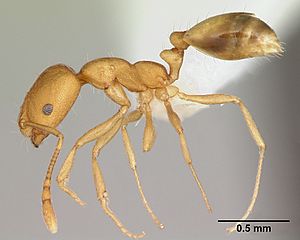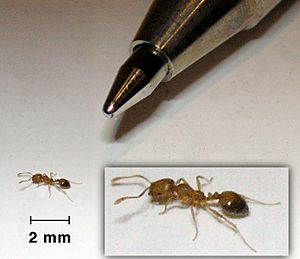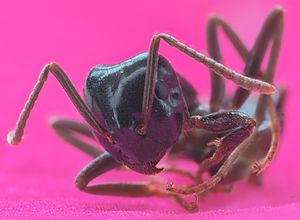Pharaoh ant facts for kids
Quick facts for kids Pharaoh ant |
|
|---|---|
 |
|
| Scientific classification | |
| Synonyms | |
|
Formica pharaonis |
The pharaoh ant (Monomorium pharaonis) is a tiny ant, usually about 2 millimeters long. It is yellow or light brown and almost see-through. These ants are well-known as a big problem inside buildings, especially in hospitals.
No one knows exactly where pharaoh ants first came from. But now, they live in almost every part of the world. This includes Europe, the Americas, Australia, and Southeast Asia. They are a major pest in many countries.
This type of ant is polygynous. This means each colony has many queens. This leads to special ways the different groups in the colony work together. It also lets the colony split into new smaller colonies very quickly.
Pharaoh ants are a tropical species, meaning they like warm weather. But they can live in buildings almost anywhere. They even do well in cooler parts of the world if buildings have central heating.
Contents
Physical Characteristics

Pharaoh ant workers are about 1.5 to 2 millimeters long. That's a little more than 1/16 of an inch. They are light yellow to reddish-brown. Their back part (called the abdomen) is darker.
Pharaoh ant workers have a tiny part that looks like a stinger. But they don't use it to sting. Instead, they use it to make special smells called pheromones. The narrow waist between their chest and abdomen is called a petiole and has two bumps. Their chest has no spines.
Pharaoh ants don't see very well. Their eyes have about 32 tiny lenses, called ommatidia. The last three parts of their antennae are longer and form a clear club shape.
Male pharaoh ants are about 3 millimeters long and black. They have wings but they do not fly. Queens are dark red and 3.6 to 5 millimeters long. They have wings at first, but they lose them soon after mating. Queens also do not fly.
Life Cycle and Reproduction
A pharaoh ant queen can lay hundreds of eggs during her life. At first, she lays 10 to 12 eggs in each batch. Later, she lays only four to seven eggs per batch.
If it's 27 degrees Celsius (80 degrees Fahrenheit) and 80 percent humid, the eggs hatch in five to seven days. The larva stage lasts 18 to 19 days. The pre-pupa stage is three days, and the pupa stage is nine days. It takes about four more days for the ants to become adult males or females.
From egg to adult, it takes a pharaoh ant about 38 to 45 days. This depends on the temperature and humidity. They keep breeding all year long in heated buildings. Mating happens inside the nest. Full-grown colonies have several queens, winged males, workers, eggs, larvae, and pupae.
How Colonies Grow and Spread
Each ant colony makes new ants that can reproduce about twice a year. Colonies grow by "budding." This is when a part of the colony, including queens, workers, and young ants (eggs, larvae, and pupae), leaves the main colony. They go to a new nest spot.
Pharaoh ant colonies seem to like nests they already know better than new ones when they bud. This might mean colonies can remember things about their living space. But if a new nest is much better, the colony might move there eventually. They try to find the best new home without spending too much time looking.
The number of places where new colonies can bud affects how much the colony splits. Many new nest spots mean smaller colony parts. This shows that the colony can control its size and how many ants of each type it has. However, a group of at least 469 ants seems to be what they prefer.
After budding, the new nest groups don't fight for food. Instead, they work together. This is because the ants in these groups are very closely related. Also, if the main nest is disturbed, the colony might leave it and move to a new bud nest. This means the groups might even share ants after budding, which helps them cooperate.
In Australia, Monomorium ants are very successful. This is interesting because of another aggressive ant family there, Iridomyrmex. These ants are good at finding food and stopping other ants from getting it. But Monomorium ants, even though they are small and not aggressive, do well where Iridomyrmex ants live. They are good at finding food and use special chemical signals (from their venom) to keep other ants away. With these two skills, Monomorium ants can quickly take over and protect food sources.
Pheromones (Special Smells)
Pharaoh ants use three kinds of pheromones. Pheromones are special chemical smells that ants use to communicate.
One pheromone is a long-lasting smell that attracts other ants. They use it to build a network of trails. This smell stays on the trail even if ants don't use it for several days. Pharaoh ants stop working at night and start again around 8 AM. Parts of their trail network are the same every day.
The second pheromone also attracts ants. But this smell fades away in minutes if ants don't keep adding it. This pheromone is good for marking food spots. Food sources can be hard to predict, so the colony needs to react quickly. Ants won't waste time on a trail that doesn't lead to food.
The third pheromone is a repellent. Pharaoh ants were the first ants found to use a "negative" trail pheromone. If an ant finds a bad area with little food or danger, it releases this repellent smell. This warns other ants to look somewhere else. While most social insects use positive pheromones to show good food spots, the pharaoh ant's negative pheromone is very unusual. Like the food marker, this negative pheromone disappears after about two hours. It can even act like an insecticide in some cases. It is so strong that an ant can smell it from 30 millimeters away. Pharaoh ants use this pheromone near forks in their trails. An ant that smells it will start walking in a zigzag way.
Both the attractive and repellent pheromones help ants decide where to go when they are foraging (looking for food). The repellent pheromone is especially helpful for changing trails when new food is found. It also stops ants from going to trails that are not good. This makes the pharaoh ant a very good forager. Even though pheromones are very important, ants use them carefully. This helps them communicate better during important times, like when they move their nest.
Foraging (Finding Food)
Pharaoh ants use a "positive feedback" system to find food. Each morning, scout ants go out to search. When a scout finds food, it quickly goes back to the nest. This makes several other ants follow the successful scout's trail back to the food. Soon, a large group will be at the food source. Scouts likely use both smells and sights to know where the nest is and how to get back. If the colony is exploring a new area, they use a "land rush" method. Many foragers search randomly, constantly releasing pheromones.
Even though pharaoh ants are often seen as indoor pests, they actually look for food more often outside. Even colonies living inside buildings were found to search near windows. This shows they like outdoor places.
Trails
Even though scouts search on their own, they use a clear trail system. This system stays mostly the same each day. It has one to four main "trunk" routes. Every scout uses one of these trunks at the start and end of its food search. This way, the trunks get constant chemical reinforcement and don't change much. Each trunk splits into many "branch" routes. These branches change based on where food is available.
How foraging trails are set up depends a lot on the colony's health and how much food is available. If a colony doesn't have enough food, more ants will go out to forage. If food is then given to a hungry colony, even more ants will go out. This shows how pharaoh ants recruit others. If there is no food, a colony will make its trails spread out wider from the nest. Logically, the most trails and ant traffic are closest to a food source.
Pheromones help pharaoh ants find food. But how each ant finds its way back to the nest is different. Pharaoh ants use geometry to find their way home. Each fork in their trail system spreads out at an angle between 50 and 60 degrees. When an ant is going back to the nest and finds a fork, it almost always takes the path that is straighter. It will never choose a sharp angle that would change its direction a lot. Using this rule, each ant can find its way back to the nest. If the fork angle is made wider (between 60 and 120 degrees) in experiments, the ants had a much harder time finding their nest. This way of making decisions saves energy that would be wasted by going the wrong way. It helps pharaoh ants be very efficient at foraging.
Feeding
When scouts come back with food, the queens will try to beg for some. Depending on how much food there is and how healthy the scout is, a scout might refuse the queen's request. It might even run away from her. Giving food to the queen can be good when there's plenty of food. A healthy queen can lay more eggs and help the colony grow. But when food is very scarce, an ant's own survival is more important. So, she will refuse to give up food.
A queen can also eat liquids from larvae. This creates a good cycle: more larvae give more food to queens, who then produce more larvae.
If there are many larvae and a lot of extra liquid, pharaoh ants will store the extra food. They store it in the large back parts (called gasters) of special ants called replete workers. These ants have huge gasters and can bring up their stored food when needed. This way, the colony has extra food for times when food is scarce.
Pharaoh ants have a smart way of choosing food. They use two related behaviors. The first is called "satiation." At first, workers will strongly prefer one type of food. But if they are only given this food for several weeks, they will then prefer a different type of food. This means the ants get "full" of a certain food and will change their choice. The second behavior is called "alternation." If they are always given a choice between food types, pharaoh ants will tend to switch between foods rich in carbohydrates (sugars) and foods rich in protein. These behaviors help the colony get a balanced diet.
Caste System
Monomorium pharaonis, like other ants that spread easily, is polygynous. This means its colonies have many queens, sometimes up to 200! It's thought that having many queens leads to ants not recognizing their nestmates as well. This is because there is more genetic variety. Because these colonies don't recognize nestmates, they don't fight with nearby colonies. This is called unicoloniality.
Many invasive ants show unicoloniality. This non-aggression among colonies is helpful because it avoids needless injuries. It also lets them use their resources properly, helping all the colonies succeed. Low nestmate recognition, partly caused by having many queens, also has a chemical reason in M. pharaonis.
Cuticular hydrocarbons are chemicals found on the outer skin of insects, often on their antennae. They help many social insects communicate. In ants, these chemicals are very important for recognizing nestmates. Other ant species can tell the difference in these chemicals and react accordingly. However, all pharaoh ant colonies have the same hydrocarbons on their antennae. This makes them unable to recognize nestmates well, leading to no fighting between colonies.
Pharaoh ant colonies have many queens. The number of queens compared to workers changes depending on the colony's size. A normal colony usually has 1,000–2,500 workers. But often, many nests close together make it seem like there are huge colonies. In a small colony, there will be more queens compared to workers. Also, the ants will be larger than those in a bigger colony. The workers in the colony control this ratio.
Larvae that will become workers have special hairs all over them. But larvae that will become male or female ants that can reproduce are bare. It is thought that workers can use these differences to tell the larvae apart. Workers might even eat larvae to make sure the number of each type of ant is good. This decision to eat larvae depends a lot on the current ratio of ants. For example, if there are many fertile queens, the workers might eat larvae. The ant ratios are controlled to help the colony grow as much as possible. For instance, in a small colony, the number of queens compared to workers is increased. This helps them reproduce more, allowing the colony to grow. In a large colony, having many workers compared to queens helps them find more food. This helps support the large population.
Nest Demographics
The pharaoh ant is a species with many queens. It has a fairly low number of workers compared to queens, about 12.86 workers for every queen. This allows pharaoh ants to control the size of the colony and the number of each type of ant. In an average nest, there are about 170 queens, which is about 5.2% of all the ants. There are about 2185 workers, making up about 66.6% of the population. This low worker-to-queen ratio often means quick changes in the nest. This might be why pharaoh ants form many new bud nests so fast. To split off and form a new bud nest, pharaoh ants need at least 469 ants. This explains how they spread so quickly.
Colony Interaction
When social ants meet ants from another colony, they can either act aggressively or not. Aggressive behavior is common. The attacking worker usually bites the other ant at its narrow waist (the petiole). In non-aggressive behavior, the two ants touch each other with their antennae when they meet.
For Monomorium pharaonis, their behavior is almost always non-aggressive. This is true even when the ants are from different colonies and are different types of ants. There are very few times when these ants show aggressive behavior.
Washing Behavior
After looking for food, pharaoh ants will clean themselves when a worker enters the cell. They also wash after a long meal. It is thought that washing helps keep the nest clean. This can prevent diseases and keep things tidy. Right before workers leave to find food, they might also wash themselves. However, at this time, the washing is very strong and often makes the ants fall over. It is believed that this washing behavior here is not for cleaning. Instead, it might be a sign that the ants are deciding whether or not to leave the nest.
Invasiveness and Control
Budding is a main reason why pharaoh ants spread so easily. A single starting colony can fill a large office building in less than six months. They can even push out almost all other insect pests. Getting rid of and controlling them is hard. This is because many colonies can join together into smaller ones during pest control efforts. Then, they can grow back later.
Pharaoh ants have become a serious pest in almost every type of building. They can eat many different foods. These include grease, sugary foods, and dead insects. They can also chew holes in silk, rayon, and rubber items. Their nests can be very small, which makes them even harder to find. Nests are usually found in wall spaces, under floors, or in different kinds of furniture. In homes, they are often found looking for food in bathrooms or near food.
It is not recommended to try to get rid of them using insect sprays and dusts. These will make the pharaoh ants scatter and cause colonies to split. However, some non-repellent insecticides have been reported to work.
The best way to get rid of pharaoh ants is by using baits that they like. Modern baits use special chemicals called insect growth regulators (IGRs). The ants are attracted to the bait because of its food content. They take it back to the nest. Over a few weeks, the IGR stops new worker ants from being made. It also makes the queen unable to have babies. You might need to replace the baits once or twice.
Pharaoh ants and other ants have also been gotten rid of using baits made of 1% boric acid and sugar water.



